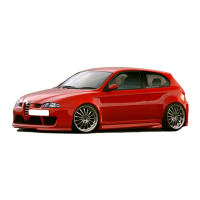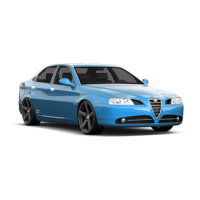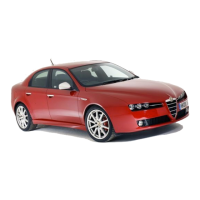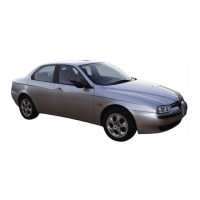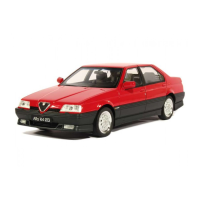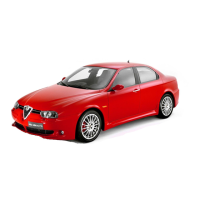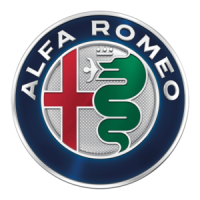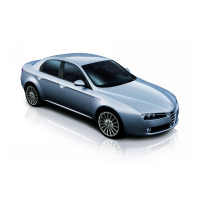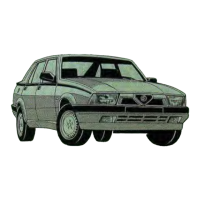Do you have a question about the Alfa Romeo 147 and is the answer not in the manual?
Indicates rules that, if ignored, may lead to serious injury. Warnings are presented with a triangular symbol.
Highlights rules that, if ignored, may cause serious damage to the car or forfeiture of warranty cover.
Explains the electronic engine lock system activated automatically when the key is removed from the ignition.
Describes the components and operation of the electronic alarm system, including activation and deactivation.
Explains the operation of power windows, including the continuous automatic operation device.
Provides instructions on how to use seat belts correctly, including fastening and unfastening procedures.
Explains the correct way to wear seat belts and how to fasten and unfasten them securely.
Explains the function of pre-tensioning devices in front seat belts for increased efficiency and tighter adherence.
Outlines general instructions for seat belt use, emphasizing compliance with traffic laws and correct positioning.
Emphasizes the importance of proper restraint systems for children and the mandatory prescription according to EC Directive 2003/20/EC.
Introduces the car's air bag system, including front, passenger, side, and window bags.
Details the description and operation of front air bags, emphasizing their role as a safety device in head-on collisions.
Explains the design of the passenger's front air bag to improve protection and the manual deactivation process.
Describes side and window bags, their function in increasing side crash protection, and proper occupant positioning.
Provides general safety precautions related to air bags, including hand positioning, driving posture, and avoiding objects.
Details the operation of the windscreen wiper and washer, including intermittent speeds and the 'smart washing' function.
Introduces the electronic speed regulator (CRUISE CONTROL) for maintaining speed without accelerator pedal use.
Provides a labeled diagram of the dashboard, identifying various controls and indicators.
Explains the instrument panel displays for petrol versions with digital multifunction display.
Describes the engine coolant temperature gauge and the warning light, emphasizing actions for high temperatures.
Details the information displayed by the digital multifunction display and the control buttons used to access it.
Details how to check the engine oil level using the digital display, including correct procedure and interpretation of readings.
Details how to check the engine oil level on JTDM versions, including correct procedure and interpretation of readings.
Explains the 'Trip computer' function which provides information on the car's operating status via the display.
Provides information on warning lights and indicators, noting their presence depends on car equipment.
Explains the warning light for low brake fluid, indicating a possible leak in the circuit.
Explains the temperature gauge and warning light for high engine coolant temperature, advising immediate actions.
Details the warning light for air bag system failure, indicating steady illumination if there's an operating failure.
Describes the warning light that illuminates if the driver's seat belt is not correctly fastened when the ignition is on.
Indicates the message shown on the display in case of transmission failure for Selespeed versions.
Describes the amber warning light and message indicating a fault in the EOBD system affecting emissions or performance.
Explains the amber warning light for the Alfa Romeo CODE system, indicating possible failure or deactivation.
Describes the amber warning light for glow plugs warming, indicating it turns off when the pre-established temperature is reached.
Describes the amber warning light for water in the fuel oil filter, warning of potential damage to the injection system.
Explains the amber warning light for a clogged diesel particulate filter, advising driving until the light goes off.
Explains the amber warning light indicating an inefficient ABS system, where braking effectiveness is maintained but anti-lock is absent.
Describes the red and amber warning lights indicating an EBD system failure, warning of potential rear wheel lock during braking.
Explains the amber warning light that turns on when the passenger's front air bag is deactivated.
Describes the amber warning light for the VDC system, indicating its cutting in during critical stability conditions.
Explains the ASR function that controls car drive and cuts in automatically when driving wheels slip.
Provides a description of the heating and manual climate control system, noting differences between versions.
Explains the MAX-DEF function for quick demisting/defrosting, detailing activated features and manual operations.
Explains how to start the automatic two-zone climate control system and personalize temperatures.
Lists and describes all controls for the climate control system, including temperature knobs, fan speed, and buttons.
Explains how to start the automatic two-zone climate control system and personalize temperatures.
Explains the HI function for maximum heating power, its activation, and advisories for use with a cold engine.
Describes the LO function for maximum cooling power, its activation, and advisory for use in hot climates.
Describes the compressor button function, its limitations with external temperature, and its interaction with air recirculation.
Details how the AUTO button automatically adjusts air amount and distribution, cancelling manual settings.
Explains the MAX-DEF function for quick demisting/defrosting, detailing activated features and manual operations.
Provides a labeled diagram of climate control panel buttons: tailgate release, hazard lights, fog lights.
Details the hand brake lever operation, its warning light, and safety checks for correct adjustment.
Explains the gearshift lever positions and warnings for smooth gear changes, emphasizing clutch pedal use.
Introduces the Selespeed transmission, its benefits, and the importance of understanding correct operations.
Explains how gearbox failures are shown via warning light and message, advising contact with Alfa Romeo Authorised Services.
Provides instructions for starting the engine with the gearbox engaged or in neutral, and warnings about engine failure.
Explains how to switch off the engine and deactivate the Selespeed system, with warnings about leaving the car in neutral.
Explains emergency starting procedures using the CODE card when the Alfa Romeo CODE system fails.
Describes how to engage gears for moving off, including reverse gear engagement and handling of gear shifting issues.
Details the MANUAL mode where the driver decides gear changes, through the control lever or steering wheel spokes.
Explains the CITY mode where the system decides gear changes based on engine RPM and driving style.
Describes how Selespeed gearbox failures are indicated by a warning light and message, advising contact with Alfa Romeo Authorised Services.
Provides solutions for common problems related to the Bluetooth handsfree system, audio quality, and connection issues.
Provides instructions for refuelling petrol and JTD engines, including warnings about leaded petrol and fuel types.
Specifies the use of only four-star unleaded petrol with octane number (R.O.N.) of 95 or over for petrol engines.
Mandates the use of fuel oil conforming to European Specification EN590 for JTD engines, warning against other products.
Explains the DPF's function in trapping carbon particles and the regeneration process, including warning light indications.
Provides general guidelines for the correct use of the car, including starting the engine and initial driving period.
Details the procedure for starting the engine, including the electronic engine lock device and safety warnings.
Provides instructions and warnings for towing the car, including gear selection and steering lock engagement.
Provides guidance on actions to take in the event of an accident, emphasizing calmness, safety, and calling emergency services.
Offers advice on how to assist injured people, including reassurance, seat belt release, and moving them safely.
Introduces the importance of correct maintenance for long car life and mentions Alfa Romeo's programmed maintenance schedule.
Highlights Alfa Romeo's programmed maintenance schedule of checks and operations every 20,000 km.
Presents a table detailing maintenance checks required at various mileage intervals (thousands of km).
Provides guidance on checking various fluid levels, emphasizing caution with fluids and avoiding contamination.
Details how to check engine oil level, including warnings about oil specifications and working with a hot engine.
Explains how to check Selespeed transmission oil level, warning against using incorrect oil specifications.
Describes how to check brake and clutch fluid levels, warning about the fluid's corrosive nature and hygroscopic properties.
Warns about water in the diesel fuel circuit causing engine damage and irregular running, indicating the relevant warning light.
Provides information on battery charging procedures, advising professional execution and warnings about frozen or improperly handled batteries.
Provides precautions for work on the electric system or emergency starting, including battery disconnection and warnings about incorrect repairs.
Emphasizes checking tyre pressure, warnings about incorrect pressure, and the importance of correct tyre fitting and replacement.
Advises checking tyre pressure regularly, including the spare, and provides information on interpreting tyre wear patterns.
Provides identification data including labels for vehicle identification, bodywork, and engine.
Provides a table listing engine codes and corresponding body versions for 3-door and 5-door models.
Presents a detailed table of engine specifications for various models, including code, cycle, cylinders, bore, stroke, displacement, and compression ratio.
Details fuel supply systems for different engine types, including Multi Point injection and Multijet direct injection.
Describes the gearbox, clutch, and drive systems for various engine and transmission types.
Lists standard and optional fittings for rims and tyres, including winter tyre specifications and inflation pressures.
Provides tables for tyre inflation pressures for reduced load and full load, including notes on unchainable tyres and winter tyres.
Explains how to read tyre codes (width, aspect ratio, construction, rim diameter, speed index) and load index.
Presents a table detailing maximum speed, acceleration from 0-100 km/h, and kilometer with standing start for various models.
Provides a table detailing fluid capacities for fuel tank, engine cooling system, oil sump, transmission, power steering, brake circuit, and washer reservoir.
Illustrates the instrument panel for petrol versions with digital multifunction display and Black Line/Q2 versions.
Indicates rules that, if ignored, may lead to serious injury. Warnings are presented with a triangular symbol.
Highlights rules that, if ignored, may cause serious damage to the car or forfeiture of warranty cover.
Explains the electronic engine lock system activated automatically when the key is removed from the ignition.
Describes the components and operation of the electronic alarm system, including activation and deactivation.
Explains the operation of power windows, including the continuous automatic operation device.
Provides instructions on how to use seat belts correctly, including fastening and unfastening procedures.
Explains the correct way to wear seat belts and how to fasten and unfasten them securely.
Explains the function of pre-tensioning devices in front seat belts for increased efficiency and tighter adherence.
Outlines general instructions for seat belt use, emphasizing compliance with traffic laws and correct positioning.
Emphasizes the importance of proper restraint systems for children and the mandatory prescription according to EC Directive 2003/20/EC.
Introduces the car's air bag system, including front, passenger, side, and window bags.
Details the description and operation of front air bags, emphasizing their role as a safety device in head-on collisions.
Explains the design of the passenger's front air bag to improve protection and the manual deactivation process.
Describes side and window bags, their function in increasing side crash protection, and proper occupant positioning.
Provides general safety precautions related to air bags, including hand positioning, driving posture, and avoiding objects.
Details the operation of the windscreen wiper and washer, including intermittent speeds and the 'smart washing' function.
Introduces the electronic speed regulator (CRUISE CONTROL) for maintaining speed without accelerator pedal use.
Provides a labeled diagram of the dashboard, identifying various controls and indicators.
Explains the instrument panel displays for petrol versions with digital multifunction display.
Describes the engine coolant temperature gauge and the warning light, emphasizing actions for high temperatures.
Details the information displayed by the digital multifunction display and the control buttons used to access it.
Details how to check the engine oil level using the digital display, including correct procedure and interpretation of readings.
Details how to check the engine oil level on JTDM versions, including correct procedure and interpretation of readings.
Explains the 'Trip computer' function which provides information on the car's operating status via the display.
Provides information on warning lights and indicators, noting their presence depends on car equipment.
Explains the warning light for low brake fluid, indicating a possible leak in the circuit.
Explains the temperature gauge and warning light for high engine coolant temperature, advising immediate actions.
Details the warning light for air bag system failure, indicating steady illumination if there's an operating failure.
Describes the warning light that illuminates if the driver's seat belt is not correctly fastened when the ignition is on.
Indicates the message shown on the display in case of transmission failure for Selespeed versions.
Describes the amber warning light and message indicating a fault in the EOBD system affecting emissions or performance.
Explains the amber warning light for the Alfa Romeo CODE system, indicating possible failure or deactivation.
Describes the amber warning light for glow plugs warming, indicating it turns off when the pre-established temperature is reached.
Describes the amber warning light for water in the fuel oil filter, warning of potential damage to the injection system.
Explains the amber warning light for a clogged diesel particulate filter, advising driving until the light goes off.
Explains the amber warning light indicating an inefficient ABS system, where braking effectiveness is maintained but anti-lock is absent.
Describes the red and amber warning lights indicating an EBD system failure, warning of potential rear wheel lock during braking.
Explains the amber warning light that turns on when the passenger's front air bag is deactivated.
Describes the amber warning light for the VDC system, indicating its cutting in during critical stability conditions.
Explains the ASR function that controls car drive and cuts in automatically when driving wheels slip.
Provides a description of the heating and manual climate control system, noting differences between versions.
Explains the MAX-DEF function for quick demisting/defrosting, detailing activated features and manual operations.
Explains how to start the automatic two-zone climate control system and personalize temperatures.
Lists and describes all controls for the climate control system, including temperature knobs, fan speed, and buttons.
Explains how to start the automatic two-zone climate control system and personalize temperatures.
Explains the HI function for maximum heating power, its activation, and advisories for use with a cold engine.
Describes the LO function for maximum cooling power, its activation, and advisory for use in hot climates.
Describes the compressor button function, its limitations with external temperature, and its interaction with air recirculation.
Details how the AUTO button automatically adjusts air amount and distribution, cancelling manual settings.
Explains the MAX-DEF function for quick demisting/defrosting, detailing activated features and manual operations.
Provides a labeled diagram of climate control panel buttons: tailgate release, hazard lights, fog lights.
Details the hand brake lever operation, its warning light, and safety checks for correct adjustment.
Explains the gearshift lever positions and warnings for smooth gear changes, emphasizing clutch pedal use.
Introduces the Selespeed transmission, its benefits, and the importance of understanding correct operations.
Explains how gearbox failures are shown via warning light and message, advising contact with Alfa Romeo Authorised Services.
Provides instructions for starting the engine with the gearbox engaged or in neutral, and warnings about engine failure.
Explains how to switch off the engine and deactivate the Selespeed system, with warnings about leaving the car in neutral.
Explains emergency starting procedures using the CODE card when the Alfa Romeo CODE system fails.
Describes how to engage gears for moving off, including reverse gear engagement and handling of gear shifting issues.
Details the MANUAL mode where the driver decides gear changes, through the control lever or steering wheel spokes.
Explains the CITY mode where the system decides gear changes based on engine RPM and driving style.
Describes how Selespeed gearbox failures are indicated by a warning light and message, advising contact with Alfa Romeo Authorised Services.
Provides solutions for common problems related to the Bluetooth handsfree system, audio quality, and connection issues.
Provides instructions for refuelling petrol and JTD engines, including warnings about leaded petrol and fuel types.
Specifies the use of only four-star unleaded petrol with octane number (R.O.N.) of 95 or over for petrol engines.
Mandates the use of fuel oil conforming to European Specification EN590 for JTD engines, warning against other products.
Explains the DPF's function in trapping carbon particles and the regeneration process, including warning light indications.
Provides general guidelines for the correct use of the car, including starting the engine and initial driving period.
Details the procedure for starting the engine, including the electronic engine lock device and safety warnings.
Provides instructions and warnings for towing the car, including gear selection and steering lock engagement.
Provides guidance on actions to take in the event of an accident, emphasizing calmness, safety, and calling emergency services.
Offers advice on how to assist injured people, including reassurance, seat belt release, and moving them safely.
Introduces the importance of correct maintenance for long car life and mentions Alfa Romeo's programmed maintenance schedule.
Highlights Alfa Romeo's programmed maintenance schedule of checks and operations every 20,000 km.
Presents a table detailing maintenance checks required at various mileage intervals (thousands of km).
Provides guidance on checking various fluid levels, emphasizing caution with fluids and avoiding contamination.
Details how to check engine oil level, including warnings about oil specifications and working with a hot engine.
Explains how to check Selespeed transmission oil level, warning against using incorrect oil specifications.
Describes how to check brake and clutch fluid levels, warning about the fluid's corrosive nature and hygroscopic properties.
Warns about water in the diesel fuel circuit causing engine damage and irregular running, indicating the relevant warning light.
Provides information on battery charging procedures, advising professional execution and warnings about frozen or improperly handled batteries.
Provides precautions for work on the electric system or emergency starting, including battery disconnection and warnings about incorrect repairs.
Emphasizes checking tyre pressure, warnings about incorrect pressure, and the importance of correct tyre fitting and replacement.
Advises checking tyre pressure regularly, including the spare, and provides information on interpreting tyre wear patterns.
Provides identification data including labels for vehicle identification, bodywork, and engine.
Provides a table listing engine codes and corresponding body versions for 3-door and 5-door models.
Presents a detailed table of engine specifications for various models, including code, cycle, cylinders, bore, stroke, displacement, and compression ratio.
Details fuel supply systems for different engine types, including Multi Point injection and Multijet direct injection.
Describes the gearbox, clutch, and drive systems for various engine and transmission types.
Lists standard and optional fittings for rims and tyres, including winter tyre specifications and inflation pressures.
Provides tables for tyre inflation pressures for reduced load and full load, including notes on unchainable tyres and winter tyres.
Explains how to read tyre codes (width, aspect ratio, construction, rim diameter, speed index) and load index.
Presents a table detailing maximum speed, acceleration from 0-100 km/h, and kilometer with standing start for various models.
Provides a table detailing fluid capacities for fuel tank, engine cooling system, oil sump, transmission, power steering, brake circuit, and washer reservoir.
Illustrates the instrument panel for petrol versions with digital multifunction display and Black Line/Q2 versions.
| Brand | Alfa Romeo |
|---|---|
| Model | 147 |
| Category | Automobile |
| Language | English |
